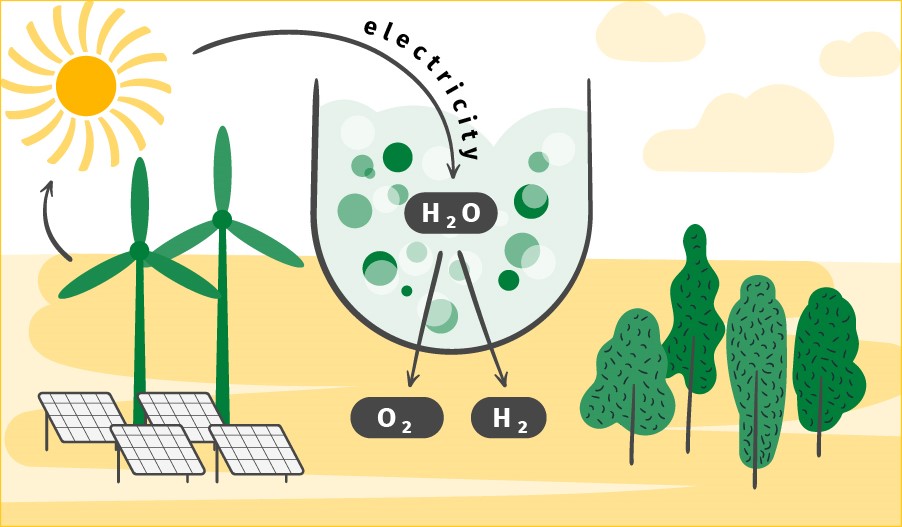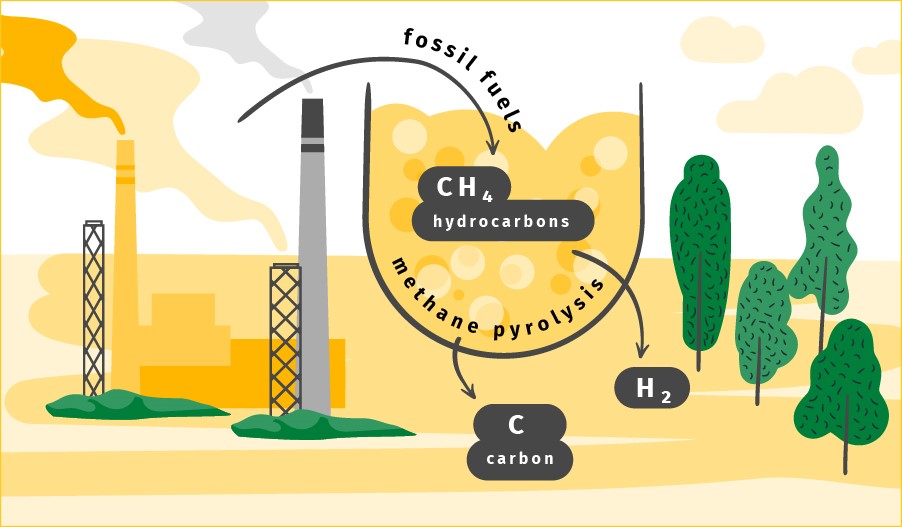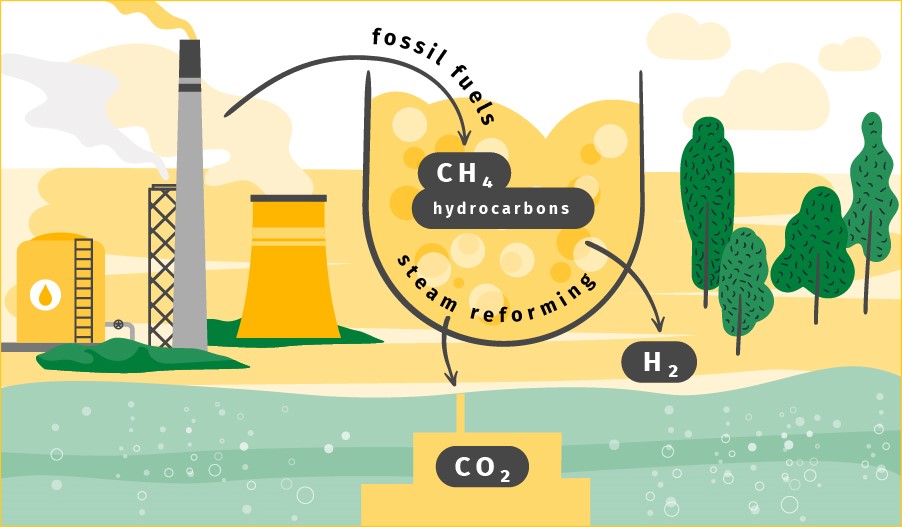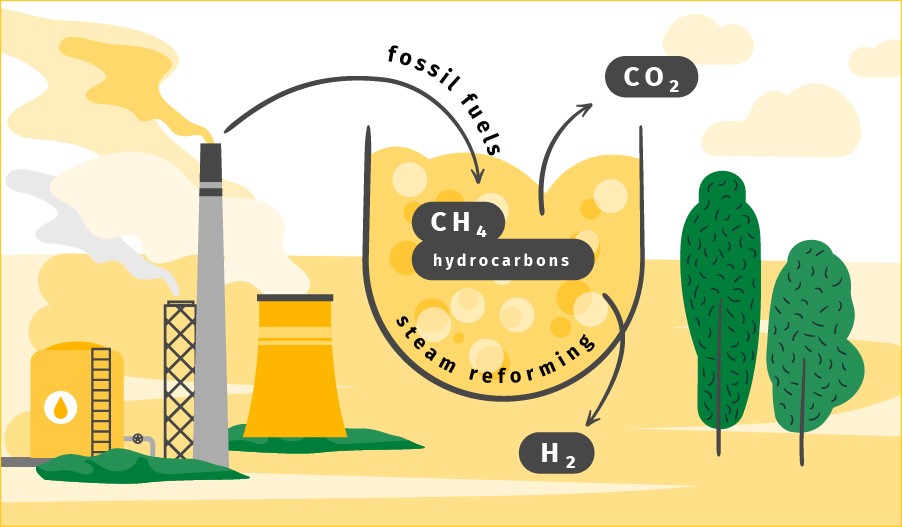Versatile uses, 100 percent storable: hydrogen
Hydrogen will play a major role in the provision of climate-neutral energy - this is our firm conviction. And what is best of all: it lends itself optimally to storage. Which is why we have big plans for hydrogen in the future.
What makes hydrogen so special?
Hydrogen is the first element in the periodic table, and for good reason: The chemical element "H" is found in almost all organic compounds. In water (H2O), for example, the very basis for life on our planet. In its gaseous form, moreover, hydrogen is a versatile energy carrier. Hydrogen can power vehicles and factories, provide cozy home heating and store electrical energy – without climate-damaging emissions and using the existing gas infrastructure.
How is hydrogen produced? And why does it come in several colors?
Hydrogen is a colorless gas and can be produced using various methods, each with different effects on the climate. For this reason, the hydrogen industry has defined several color codes that can help one identify the carbon footprint of each category of hydrogen. The colors are not relevant for storage, however, since the chemical properties of the gas always remain the same.
Here is an overview of the four most important colors and what they mean:
Green hydrogen
- Produced exclusively from renewable energies such as wind, water or solar.
- The most common method used is electrolysis: electrolyzers powered by green electricity serve to split off hydrogen from oxygen.
- 100 percent climate-neutral.
Turquoise hydrogen
- Produced through the thermal splitting of methane.
- The most common method used is methane pyrolysis: methane is split off from natural gas, thereby producing solid carbon instead of CO2.
- Can be climate-neutral if the methane pyrolysis is carried out with renewable energy and the carbon is permanently bound.
Blue hydrogen
- Produced from fossil fuels with subsequent processing.
- The most common method used is CCS (Carbon Capture and Storage): The CO2 generated during production from fossil fuels is captured and then stored.
- Climate neutral, since no CO2 is released into the atmosphere.
Grey hydrogen
- Produced from fossil fuels.
- The most common method used is steam reforming: natural gas is split into hydrogen and carbon dioxide; the latter is released into the atmosphere as waste gas. An alternative is electrolysis using gray electricity.
- Entails high emissions of greenhouse gases.
Summing up:
- Hydrogen can be produced in different ways; the colors indicate the carbon footprint of the production method used.
- When combusted, hydrogen does not release any substances that are harmful to the climate or to the environment.
Hydrogen can be integrated into existing gas infrastructures where it can transported and stored.
So why is hydrogen storage so valuable for our energy system?
With our future hydrogen storage facilities, we intend to make a decisive contribution to a climate-neutral world. The underground storage of hydrogen performs no less than five important functions for the energy system (see below). Optimizing this process will be our way of helping to speed the transition to complete decarbonization!
Ensuring reliable supplies
The storage of gas helps ensures the availability of reliable supplies at all times. Gas storage facilities can be filled all year round and can provide the necessary energy reserves during periods of peak consumption, such as in winter. This function will become even more important in the future: Although producing green hydrogen from renewable sources is the preferred method, it is not always consistent and predictable, so it is critical that fluctuations in production and demand can be flexibly balanced out.
Boosting system stability
The exploitation of hydrogen requires a complex overall system. A widely distributed and intelligently managed infrastructure is required for transportation, storage and distribution, whereby gas storage facilities play a particularly key role: They stabilize the entire network and in some cases even take on an alternative transport function. This makes it easy to balance and manage fluctuating consumption volumes.
Facilitating trading
Gas storage facilities make it possible to trade with foresight on the gas market. For example, traders can use virtual portals to place their gas orders well in advance and have delivery made later at a pre-specified time. By drawing on the capacity booked into a given gas storage facility, traders can earmark the agreed physical quantity of gas until it is needed by the customer. Thus, storage facilities play a key role in gas trading.
Protecting the environment
Wind and sun can be used to generate climate-neutral electrical energy, but this cannot be stored indefinitely. Converting green electricity into hydrogen is the only way to preserve these energy yields for future use. Thus, hydrogen-storage systems allow the energy market to temporarily store excess wind and photovoltaic energy and to then deploy it flexibly at times of peak demand. In the process, storage facilities reduce emissions and progressively increase the number of use cases for hydrogen as an energy carrier.
Kick-starting a new industrial ecosystem
Ramping up the use of hydrogen will also require the concomitant development of a holistically networked infrastructure. In addition to production, transportation and distribution systems, hydrogen-storage facilities will be an essential element. They will make it easier to quantify the infrastructure investments needed to achieve politically desired energy-transition targets, thereby fostering the evolution of a viable hydrogen ecosystem.



